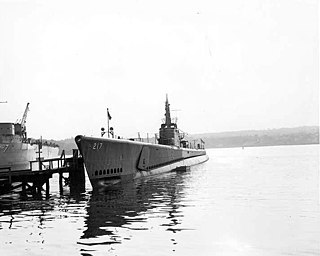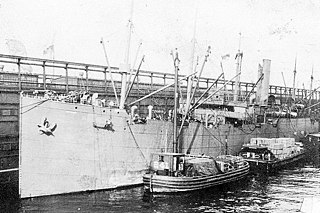
USS Guardfish (SS-217), a Gato-class submarine, was the first ship of the United States Navy to be named for the guardfish.

Jun'yō Maru (順陽丸) was a cargo steamship that was built in Scotland in 1913, served a succession of British owners until 1927, and was then in Japanese ownership until a Royal Navy submarine sank her in 1944.

Ryusei Maru was a cargo steamship that was built in England in 1911 and sunk off the coast of Bali in 1944. She was launched as Bra-Kar for Fred. Olsen & Co. of Norway. In 1916 she changed owners and was renamed Havø. In 1935 she changed owners again and was renamed Mabuhay II.
SS Sangola was a steam cargo liner that was launched in Scotland in 1901, renamed Goshu Maru in 1923, and scrapped in Japan in 1933. She was one of a class of seven steamships that were built for the British India Steam Navigation Company (BI) in 1901 and 1902. From 1908 until 1910 she took Indian indentured labourers to Fiji.
SS Vadala was a cargo steamship that was launched in Scotland in 1890, renamed Kenkon Maru No. 12 in 1913, and sank as the result of a collision in 1928. She was built for the British India Steam Navigation Company (BI). In 1895 she took Indian indentured labourers to Fiji. In 1899 was a troop ship in the Second Boer War. From 1913 she was in Japanese ownership.
SS Santhia was a steam cargo liner that was launched in Scotland in 1901, renamed Saka Maru in 1923, and scrapped in Japan in 1935. She was one of a class of seven steamships that were built for the British India Steam Navigation Company (BI) in 1901 and 1902.

Shin'yō Maru was a cargo steamship that was built in 1894, had a fifty-year career under successive British, Australian, Chinese and Greek owners, was captured by Japan in the Second World War, and sunk by a United States Navy submarine in 1944.

Empire Bittern was a steamship, built as a livestock-carrying cargo ship in 1902 at Belfast, Ireland as Iowa for the White Diamond Steamship Company Ltd of Liverpool. The ship was sold to the Hamburg America Line and renamed Bohemia in 1913.

USS Maartensdijk was a cargo steamship that was laid down in England in 1902 as Egyptiana, but launched as Rapallo. She served in the United States Navy as USS Maartensdijk from 1918 until 1919, with the Naval Registry Identification Number ID-2497.

Komagata Maru was a cargo steamship that was built in Scotland in 1890, was in German ownership until 1913, and then had a succession of Japanese owners until she was wrecked in 1926. She was launched as Stubbenhuk, renamed Sicilia in 1894, Komagata Maru in 1913 and Heian Maru in 1924.

SS Ypiranga was a cargo liner that was launched in Germany in 1908 for the Hamburg America Line (HAPAG). In 1919 the United Kingdom seized her for World War I reparations. In 1921 Anchor Line acquired her and renamed her Assyria. In 1929 the Companhia Colonial de Navegação (CCN) bought her and renamed her Colonial. In 1950 she was sold for scrap, but she sank off the coast of Scotland while being towed to a scrapyard.

HMS Baralong was a cargo steamship that was built in England in 1901, served in the Royal Navy as a Q-ship in the First World War, was sold into Japanese civilian service in 1922 and scrapped in 1933. She was renamed HMS Wyandra in 1915, Manica in 1916, Kyokuto Maru in 1922 and Shinsei Maru No. 1 in 1925.
Stettin was a 2,646 GRT cargo ship which was built in 1923 for the Stettiner Dampfer Compagnie. In 1930 she was sold to Norddeutscher Lloyd and renamed Akka. She was requisitioned by the Kriegsmarine in 1940. Akka was seized as a war prize in 1945, passing to the Ministry of War Transport (MoWT) and being renamed Empire Calder.
MV El Argentino was a refrigerated cargo motor ship that was built in Scotland in 1920 and sunk by a German aircraft in the Atlantic Ocean in 1943.
SS Hatarana was a cargo steamship that was built as part of an emergency shipbuilding programme during the First World War, and sunk without loss of life in the Battle of the Atlantic during the Second World War. She was built as War Sailor, one of a batch of cargo ships that the United Kingdom ordered from Japanese shipyards. She was renamed Hatarana in 1919 when she changed owners.

HMS Southern Prince was a motor ship that was built in 1929 as the refrigerated cargo ship Southern Prince. She was commissioned into the Royal Navy in 1940 as a minelayer. She became a headquarters ship and then an accommodation ship in 1944, was a fleet training ship in 1945, and returned to civilian trade in 1946. In 1947 she was sold to Italian owners who had her refitted as a passenger ship and renamed her Anna C. From 1952 she was a cruise ship. She was scrapped in 1972.
SS British Transport was a general cargo steamship that was built in England in 1910 and scrapped in Italy in 1933. In 1917 she became the first merchant ship to succeed in sinking a U-boat.
Compañía de Filipinas was a cargo steamship that was built in Scotland in 1890 for the Compañía General de Tabacos de Filipinas (CGTF). In the Philippine–American War the Navy of the First Philippine Republic armed her as its flagship and renamed her Filipinas. After that war she reverted to her original name and commercial service. In the Second World War, Japanese forces captured her and renamed her Hoei Maru. She was sunk in July 1945, shortly before the end of the war.

Furness Bermuda Line was a UK shipping line that operated in the 20th century. It was part of Furness, Withy and ran passenger liners between New York and the British Overseas Territory of Bermuda from 1919 to 1966.
SS Benlomond was a British cargo steamship that was built in 1922 as Cynthiana, changed owners and names a number of times, and was sunk by a U-boat in 1942, with the loss of all but one of her 53 ship's company. The sole survivor, Poon Lim, drifted on a raft for 133 days before being rescued.












